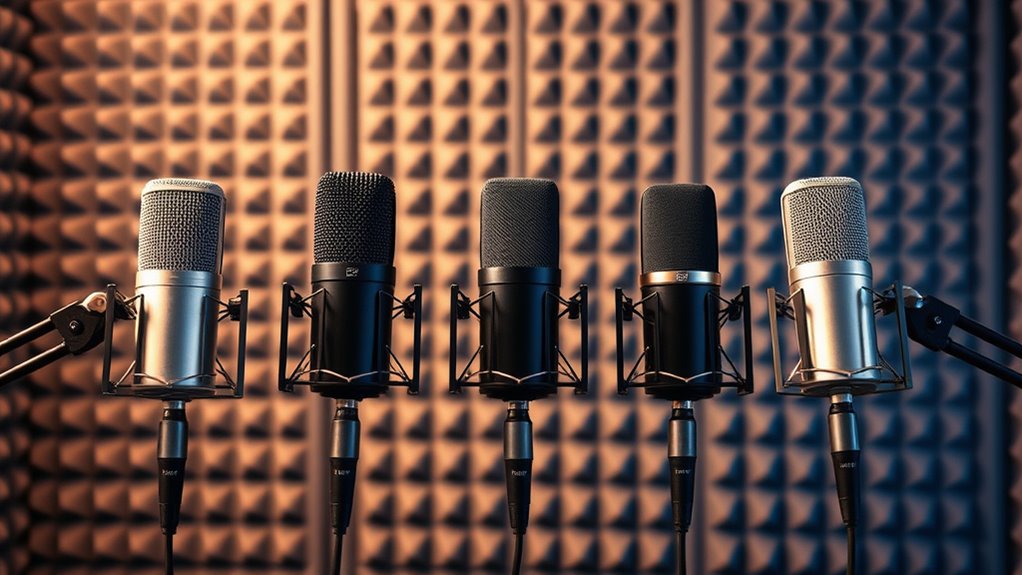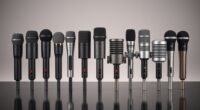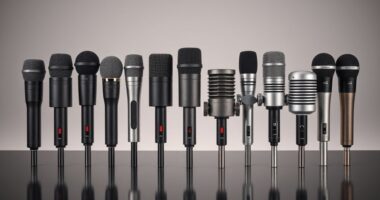If you’re looking for the best studio microphones for podcasting in 2025, I recommend considering options like the FIFINE USB and XLR mics, which deliver clear sound and easy setup. Bundles with boom arms, shock mounts, and accessories make recording sessions smoother. High-quality mics with features like noise reduction, multiple pickup patterns, and versatile connectivity suit both beginners and pros. To discover the top picks tailored for your needs, keep exploring the options ahead.
Key Takeaways
- High-resolution microphones with 192kHz/24bit sampling rate ensure crisp, detailed podcast audio quality.
- Cardioid and multiple pickup pattern mics effectively reduce background noise for clear voice recordings.
- Durable build quality and included accessories like pop filters and shock mounts enhance setup and sound isolation.
- Compatible with USB and XLR connections for versatile studio and streaming setups.
- User-friendly features such as gain controls and mute buttons simplify adjustments during recording sessions.
FIFINE USB/XLR Dynamic Microphone for Podcast and Streaming
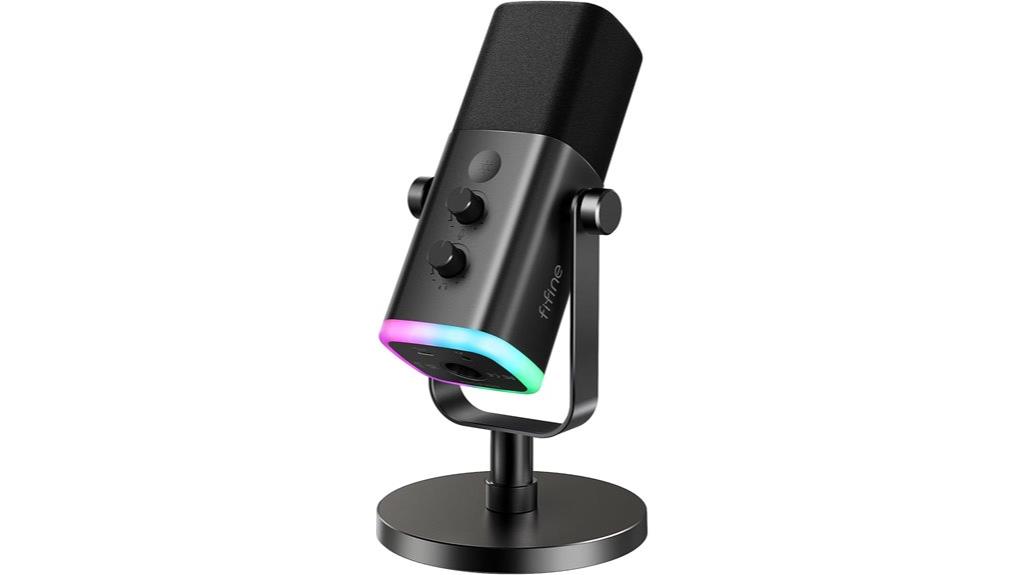
If you’re looking for a versatile microphone that suits both beginners and experienced streamers, the FIFINE USB/XLR Dynamic Microphone is an excellent choice. It offers dual connectivity—USB for quick, plug-and-play setup, and XLR for professional-grade audio quality. Built with durable ABS plastic and metal, it’s suitable for gaming, podcasting, singing, or studio work. The mic includes intuitive controls like a mute button with LED indicators, gain and monitor knobs, and RGB lighting for style. Its balanced sound, noise rejection, and flexible mounting options make it a reliable, all-in-one solution for anyone seeking clear, natural audio in any environment.
Best For: content creators, streamers, and podcasters seeking a versatile microphone with both USB and XLR options for professional-quality audio.
Pros:
- Dual connectivity provides flexibility for both beginners and professional setups
- Built-in controls and RGB lighting enhance user experience and aesthetics
- Solid, durable build with multiple mounting options and noise rejection features
Cons:
- XLR cable not included, requiring additional purchase for professional use
- Slightly larger dimensions may require dedicated desk space
- RGB lighting, while customizable, may be unnecessary for some users and could be disabled
FIFINE Studio Condenser USB Microphone with Boom Arm Stand and Shock Mount
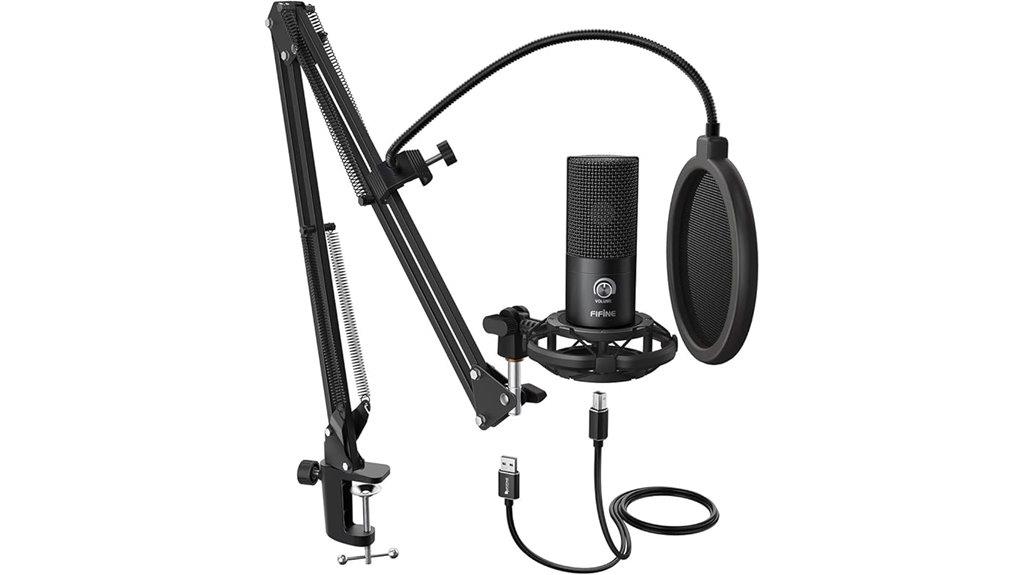
Looking for a reliable, easy-to-use microphone that delivers professional sound quality without breaking the bank? The FIFINE Studio Condenser USB Microphone with Boom Arm Stand and Shock Mount is a fantastic choice. It offers plug-and-play setup compatible with PC, Mac, PS4, and PS5—no extra drivers needed. The cardioid capsule captures focused sound, minimizing background noise for clear vocals. With a sturdy boom arm, shock mount, and pop filter included, it’s perfect for podcasts, streaming, and voiceovers. Weighing just 1.54 pounds, it’s compact, durable, and easy to position, making it an excellent mid-range option for content creators seeking quality and convenience.
Best For: content creators, streamers, and podcasters seeking an affordable, easy-to-use microphone with professional sound quality for home or studio use.
Pros:
- Plug-and-play USB setup compatible with PC, Mac, PS4, and PS5, no drivers needed
- Includes a sturdy boom arm, shock mount, and pop filter for enhanced recording quality and flexibility
- Delivers clear, warm, and focused sound with effective noise reduction, ideal for vocals and streaming
Cons:
- Not compatible with Xbox or mobile phones, limiting device versatility
- Some users experience minor wobbling or slipping with the boom arm or pop filter, requiring adjustments or modifications
- Lacks additional controls like mute button and gain adjustment, which may be a drawback for advanced users
FIFINE Dynamic Microphone for Podcast and Streaming
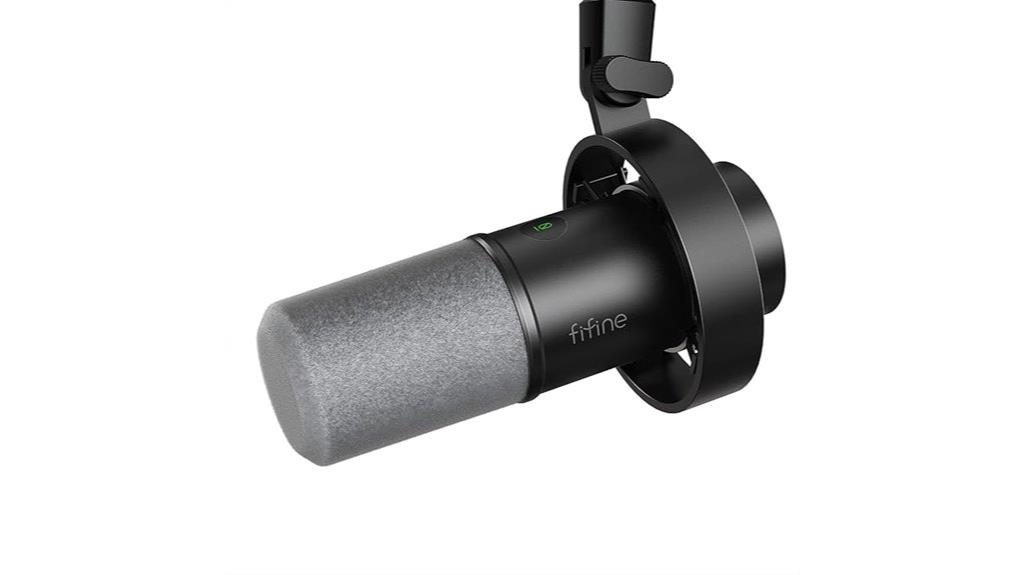
The FIFINE Dynamic Microphone for Podcast and Streaming stands out as an excellent choice for beginners and budget-conscious content creators who want professional sound quality without breaking the bank. It delivers clear, detailed audio with an SPL of 130dB and a cardioid pattern that effectively reduces background noise, making your voice stand out. The mic includes a windscreen, shock mount, and versatile connectivity options—USB for easy setup and XLR for enhanced audio quality. Its compact, durable design, along with user-friendly controls like a mute button and gain knob, make it ideal for streaming, voice-overs, and gaming. Overall, it offers fantastic value and reliable performance at an affordable price.
Best For: beginner content creators, streamers, and podcasters seeking an affordable yet high-quality microphone for professional sound.
Pros:
- Excellent sound clarity with minimal background noise due to cardioid pattern and noise reduction features
- Versatile connectivity options including USB plug-and-play and XLR for higher audio quality
- Durable, compact design with user-friendly controls like a touch-sensitive mute button and gain knob
Cons:
- XLR mute functionality is limited and only available via USB mode
- Does not include a stand or microphone arm, requiring additional accessories for optimal positioning
- Touch-sensitive mute button may not be as tactile or responsive as physical buttons
FIFINE Gaming USB Microphone for PC and PS5
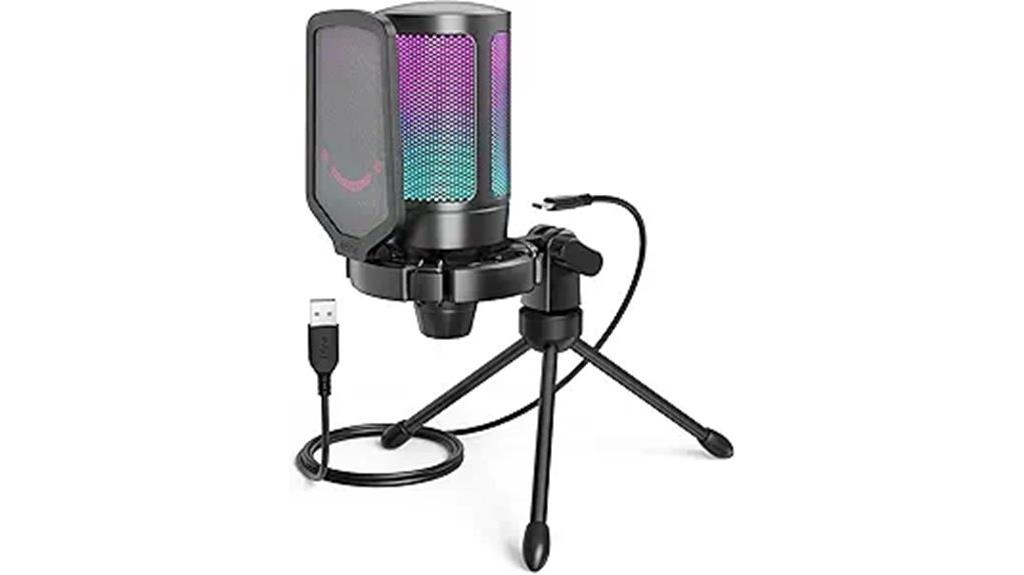
The FIFINE Gaming USB Microphone for PC and PS5 stands out as the ideal choice for gamers and streamers who want premium audio quality combined with a sleek, user-friendly design. Its 192kHz sampling rate guarantees natural, detailed sound, making team communication clear and immersive. The mic features a stylish RGB gradient with seven colors, adding vibrancy to your setup, while fixed lighting modes keep things simple. With a cardioid polar pattern and 70dB SNR, it captures vocals precisely and minimizes background noise. The quick mute button and gain control make adjustments effortless. Compatibility with multiple platforms, a durable build, and included accessories make it a versatile, professional-grade option for gaming and streaming.
Best For: gamers and streamers seeking high-quality, user-friendly microphone setup with immersive sound and vibrant lighting.
Pros:
- Premium 192kHz sampling rate delivers detailed, natural audio.
- RGB lighting with customizable colors enhances gaming ambiance.
- Easy plug-and-play compatibility with multiple platforms, including PS4, PS5, Windows, and Mac.
Cons:
- RGB lighting may be distracting for some users during focused work.
- Slightly longer setup time for optimal positioning with accessories.
- Limited advanced audio editing features compared to professional microphones.
FIFINE USB Microphone with Boom Arm Stand for Recording and Streaming
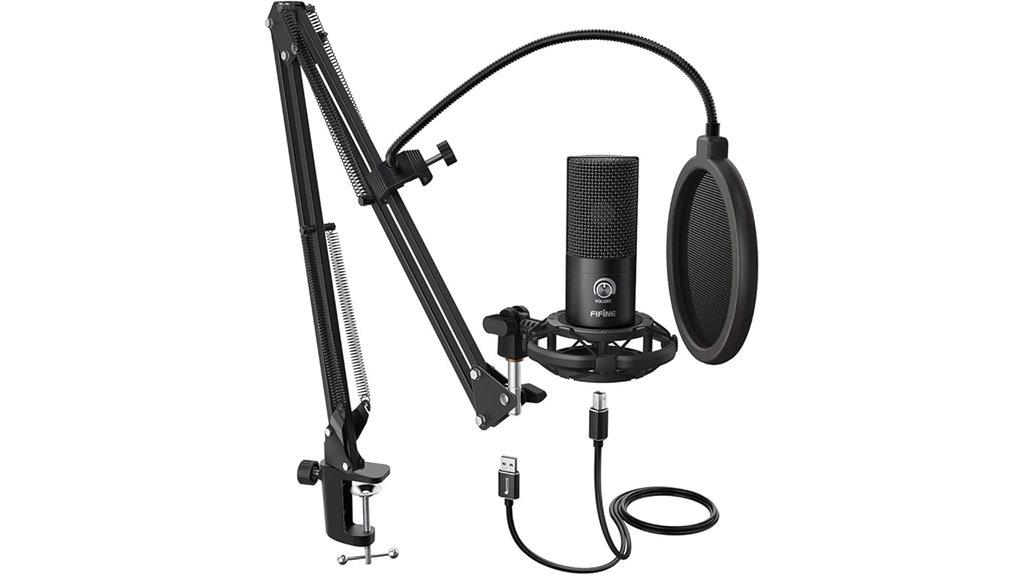
If you’re starting out or need an affordable, versatile microphone for streaming and recording, the FIFINE USB Microphone with Boom Arm Stand is an excellent choice. It offers plug-and-play setup, compatible with PC, laptop, PS4, and PS5, with no extra drivers needed. The cardioid condenser capsule captures focused sound, reducing background noise, and delivers clear, warm audio ideal for podcasts, vocals, and streaming. The kit includes a sturdy steel boom arm, shock mount, pop filter, and USB cable, making setup easy. While some may want more articulation or features, its reliable performance and great value make it a top pick for casual creators.
Best For: casual streamers, podcasters, and content creators seeking an affordable, easy-to-use microphone with plug-and-play convenience.
Pros:
- Easy setup with plug-and-play USB connection, compatible with multiple platforms including PC, PS4, and PS5
- Includes a sturdy steel boom arm, shock mount, and pop filter for professional-quality recordings
- Delivers clear, warm sound with effective background noise reduction, ideal for vocals and streaming
Cons:
- Limited articulation adjustment on the boom arm may restrict positioning flexibility
- Lacks additional features like mute button or gain control
- Some users report minor issues with the pop filter slipping or ambient noise in uncontrolled environments
MAONO XLR Condenser Microphone for Studio Recording and Streaming
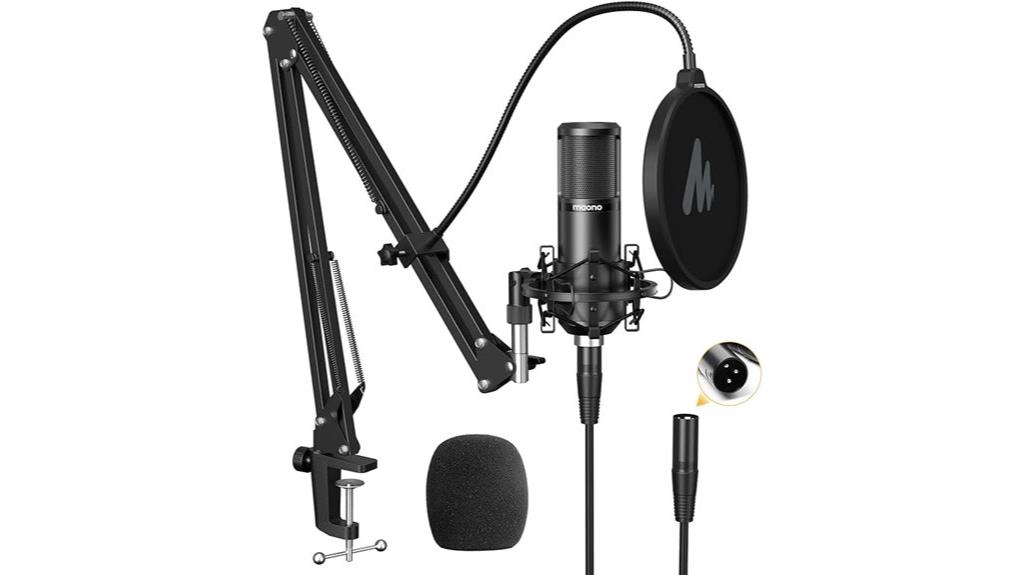
For podcasters and streamers seeking professional-quality audio on a budget, the MAONO XLR Condenser Microphone stands out with its high-performance 16mm condenser capsule and wide frequency response up to 18 KHz. Designed for clear, detailed sound, it handles vocals, instruments, and live performances with ease. Its durable full metal body, shock mount, and included accessories like a pop filter and boom arm make setup straightforward and stable. Compatible with any audio interface requiring 48V phantom power, it’s perfect for home studios or portable setups. Overall, it offers excellent value, delivering professional sound quality without breaking the bank.
Best For: content creators, streamers, and podcasters seeking professional-quality audio on a budget.
Pros:
- High-performance 16mm condenser capsule with wide frequency response up to 18 KHz for clear, detailed sound.
- Durable full metal construction with included shock mount, pop filter, and boom arm for stable, professional setup.
- Plug-and-play compatibility with any audio interface requiring 48V phantom power, making it easy to use for beginners and professionals alike.
Cons:
- Some users have experienced initial issues like broken connectors or mic malfunction.
- Packaging or component issues may occasionally occur, affecting overall satisfaction.
- Requires external audio interface with phantom power, which might add to setup complexity for some users.
MAONO Microphone with Headphone Set for Streaming and Recording
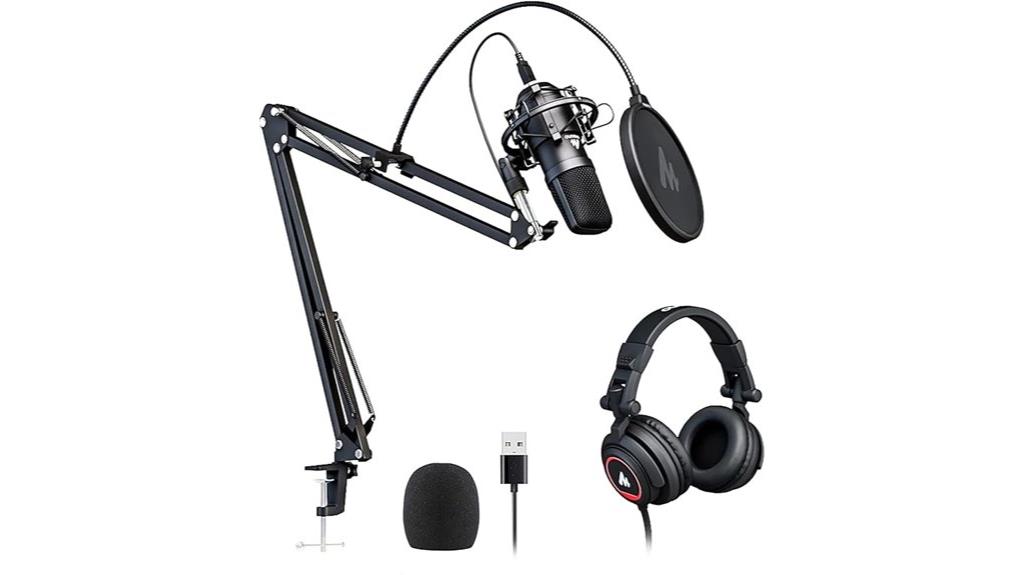
Looking for an all-in-one solution that simplifies your podcast setup? The MAONO Microphone with Headphone Set is a fantastic choice. It features a high-resolution 192kHz/24bit sound chipset, delivering crisp, detailed audio with a flat frequency response perfect for speech and streaming. The plug-and-play USB design makes setup effortless, compatible with laptops, PCs, and smartphones. The included 50mm studio headphones offer deep bass and noise reduction, ideal for monitoring. Built with durable metal, the entire bundle combines quality, convenience, and affordability, making it a reliable, versatile option for both beginners and seasoned creators.
Best For: content creators, streamers, and hobbyists seeking an all-in-one, easy-to-use podcasting and recording solution with high-quality sound and monitoring capabilities.
Pros:
- High-resolution 192kHz/24bit audio for crisp, detailed sound
- Plug-and-play USB design ensures easy setup without external drivers
- Durable metal construction with comfortable, foldable headphones for long sessions
Cons:
- Some users report minor background noise or echo issues
- Flat frequency response may not suit those needing enhanced bass or treble
- Slightly larger footprint of the full bundle might be less portable for travel
Upgraded Studio Recording Microphone with Isolation Shield & Pop Filter
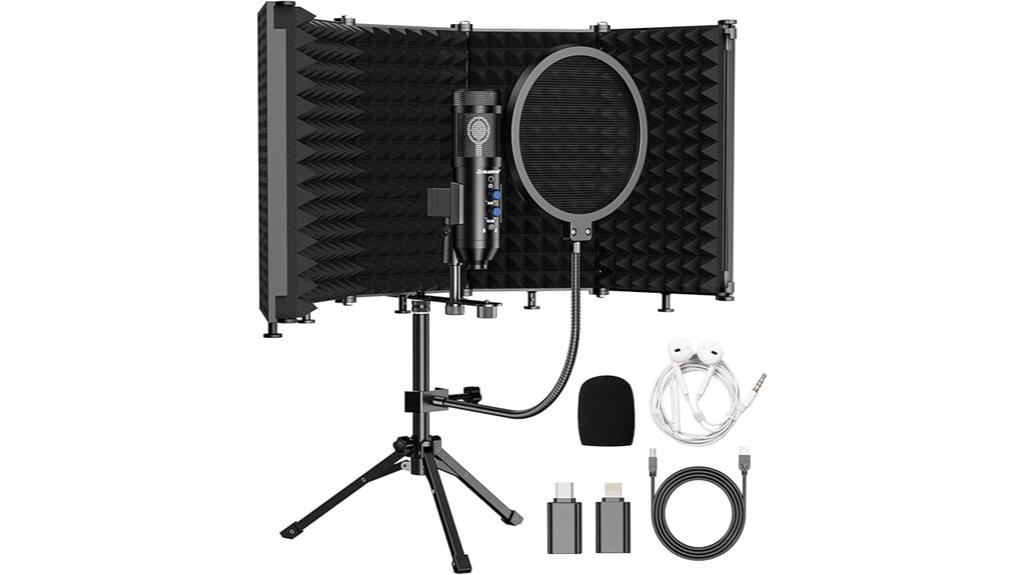
The upgraded studio recording microphone with isolation shield and pop filter is an excellent choice for podcasters and content creators seeking professional sound quality in their home studios. It offers USB connectivity for easy plug-and-play use with PCs, smartphones, or laptops. The cardioid pattern, 16mm diaphragm, and 192kHz/24Bit sampling deliver crystal-clear audio across a broad frequency range. The kit includes a sturdy metal microphone, foldable high-density soundproof shield, pop filter, tripod stand, and various adapters. The soundproof shield effectively reduces background noise, making it ideal for echo-prone spaces. Overall, it’s a versatile, easy-to-use setup that enhances recording quality without breaking the bank.
Best For: content creators, podcasters, and home studio enthusiasts seeking professional-quality audio with easy setup and noise reduction.
Pros:
- USB plug-and-play connectivity for quick and hassle-free setup
- High-quality sound with cardioid polar pattern and 192kHz/24Bit sampling rate
- Includes comprehensive accessories like isolation shield, pop filter, and adjustable tripod stand
Cons:
- Assembly can be time-consuming and may require patience
- Some users experience static noise or connection-related sound issues
- Limited noise reduction from the shield alone, may need additional soundproofing solutions
Logitech Blue Yeti USB Microphone for Gaming and Streaming
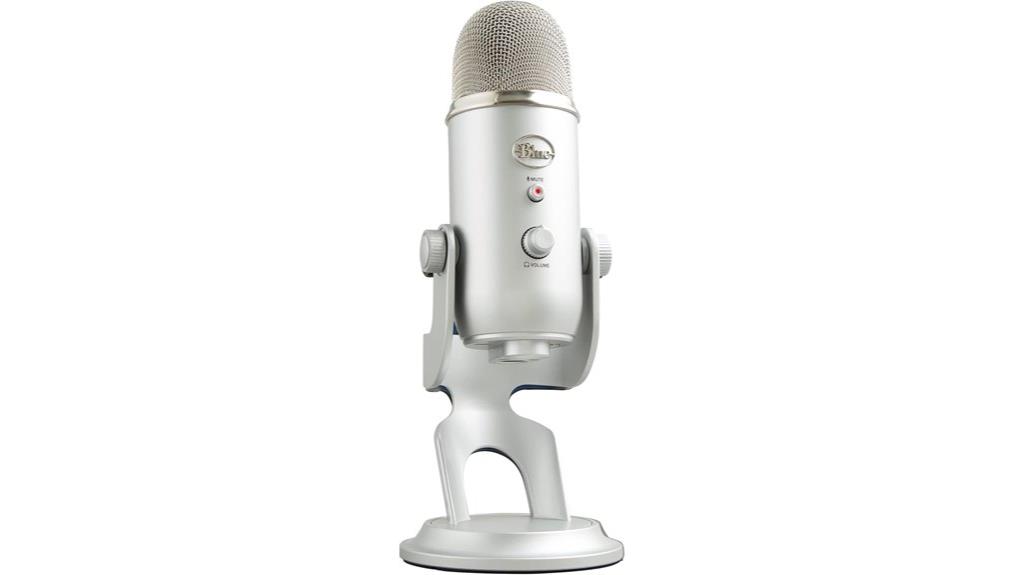
The Logitech Blue Yeti USB Microphone stands out as the top choice for gamers and streamers who want professional-quality sound without complex setup. Its sturdy metal build guarantees durability, while the adjustable pivot lets you position it perfectly for clear recordings. With four versatile pickup patterns—cardioid, bidirectional, omnidirectional, and stereo—it adapts to various recording needs, from solo streaming to multi-person chats. The intuitive controls for gain, mute, and headphone volume, plus real-time monitoring, make it user-friendly. Compatible with major streaming and recording software, the Blue Yeti delivers high-quality, broadcast-ready audio, making it ideal for content creators seeking reliable performance.
Best For: content creators, streamers, and gamers seeking professional-quality audio with easy setup and versatile recording options.
Pros:
- Durable metal construction with adjustable pivot for precise positioning
- Four pickup patterns suitable for various recording scenarios
- User-friendly controls with real-time monitoring and compatibility with streaming software
Cons:
- Slightly bulky design may require space management
- Requires software installation for full functionality, which could be a learning curve for some users
- May pick up background noise if not paired with proper isolation accessories
RØDE NT1 5th Gen Large-diaphragm Studio Condenser Microphone
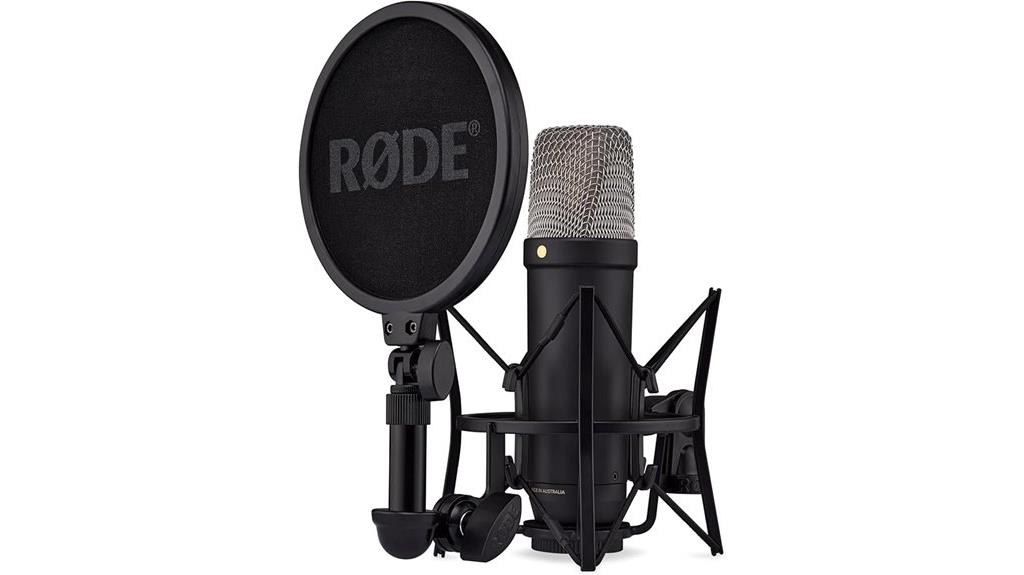
If you’re searching for a versatile microphone that combines professional-grade sound with modern connectivity options, the RØDE NT1 5th Gen is an excellent choice. It features both XLR and USB outputs, making it ideal for home or studio use without extra gear. Known for its warm, silky tone and low self-noise, it captures vocals, voiceovers, and instruments with clarity. Its durable aluminum body, shock mount, pop filter, and advanced digital processing guarantee high-quality recordings. Whether you’re podcasting, streaming, or recording music, the NT1 5th Gen offers exceptional sound and flexibility, backed by a solid reputation and user praise.
Best For: Home and professional content creators seeking a versatile microphone with both XLR and USB connectivity for vocals, voiceovers, podcasts, and instrument recordings.
Pros:
- Combines professional-grade sound with modern digital and analog connectivity options.
- Low self-noise and warm, silky tone ideal for detailed vocal and instrument capture.
- Durable construction with included accessories like shock mount and pop filter for professional use.
Cons:
- Requires a 12V battery for operation, adding a small maintenance step.
- Slightly heavier than some compact microphones, which may affect portability.
- Optimal performance depends on proper orientation and additional equipment like mounts and filters.
USB Microphone, MAONO 192KHZ/24Bit Condenser Mic Kit for Recording and Gaming
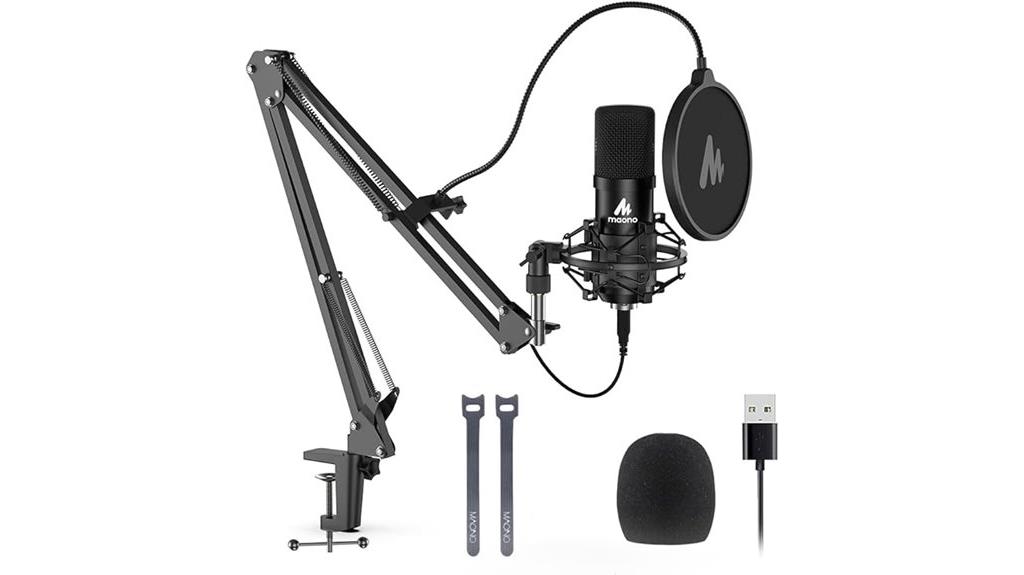
For podcasters and streamers seeking an affordable yet professional-quality microphone, the MAONO 192KHZ/24Bit Condenser Mic Kit stands out with its plug-and-play USB connectivity and high-resolution sound support. Its professional sound chipset delivers smooth, flat frequency response from 30Hz-16kHz, making it ideal for vocals, voice-overs, and streaming. The large diaphragm condenser captures crystal-clear audio with strong bass and minimal noise. Compatible with most OS and gaming consoles, it includes a sturdy boom arm, shock mount, pop filter, and accessories for versatile setup. Many users praise its sound clarity, affordability, and ease of use, making it a top choice for beginners and pros alike.
Best For: podcasters, streamers, and content creators seeking an affordable, professional-quality USB microphone for vocals, voice-overs, and streaming.
Pros:
- High-resolution 192kHz/24Bit sound quality delivers clear and professional audio.
- Plug-and-play setup with compatibility across multiple OS and gaming consoles, requiring no external sound cards.
- Comes with comprehensive accessories including a boom arm, shock mount, pop filter, and windscreen for versatile positioning and improved sound capture.
Cons:
- Some users report minor issues with mounting options and pop filter clamp stability.
- Occasional feedback of white noise or disconnection after prolonged use.
- Limited frequency response (30Hz-16kHz), which may be less suitable for certain music production needs.
MAONO XLR/USB Dynamic Microphone Kit with Accessories
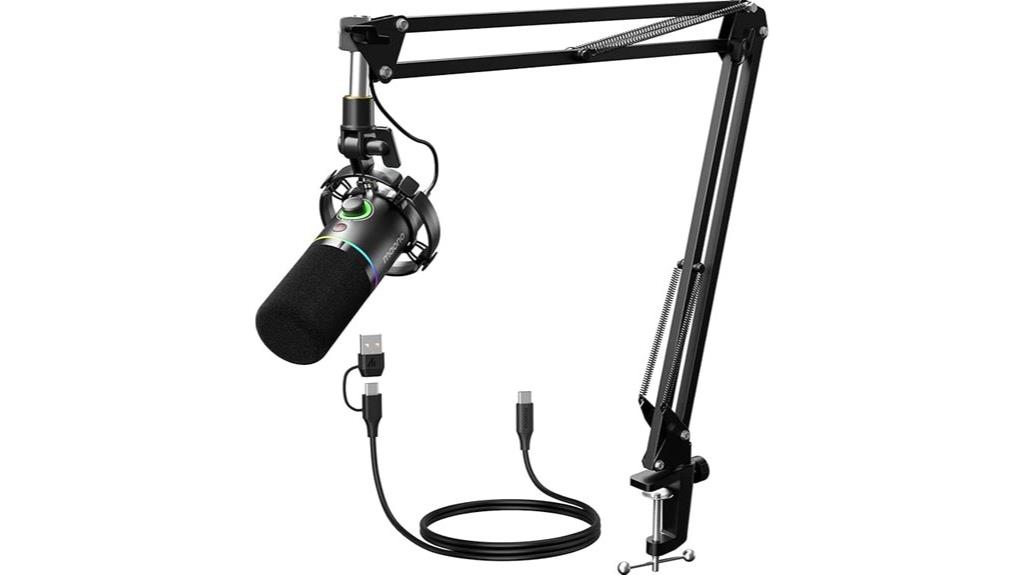
Looking for a versatile microphone kit that offers both professional XLR and convenient USB connectivity? The MAONO XLR/USB Dynamic Microphone Kit delivers crystal-clear sound with deep lows, crisp highs, and a wide frequency response of 40Hz-16KHz. Its cardioid pattern reduces background noise, making it great for podcasting, streaming, or voice-over work. The package includes a sturdy boom arm, shock mount, and accessories, all designed for easy setup. With advanced software controls, customizable RGB lighting, and hardware knobs, you can fine-tune your sound effortlessly. Its durable metal build and user-friendly features make it an excellent choice for both beginners and pros seeking reliable, high-quality audio.
Best For: content creators, streamers, and podcasters seeking versatile, high-quality audio with both USB and XLR options.
Pros:
- Excellent sound quality with deep lows and crisp highs, suitable for professional use.
- Easy to set up with plug-and-play USB connection and customizable software controls.
- Durable metal construction with included accessories like shock mount and boom arm for flexibility.
Cons:
- The arm may be lightweight and hollow, requiring careful handling or replacement.
- Software interface can be confusing for some users when adjusting settings.
- Distance from the microphone can impact audio clarity, needing proper positioning.
Movo PodPak2A 2-Pack Microphone Kit with Arm and Accessories
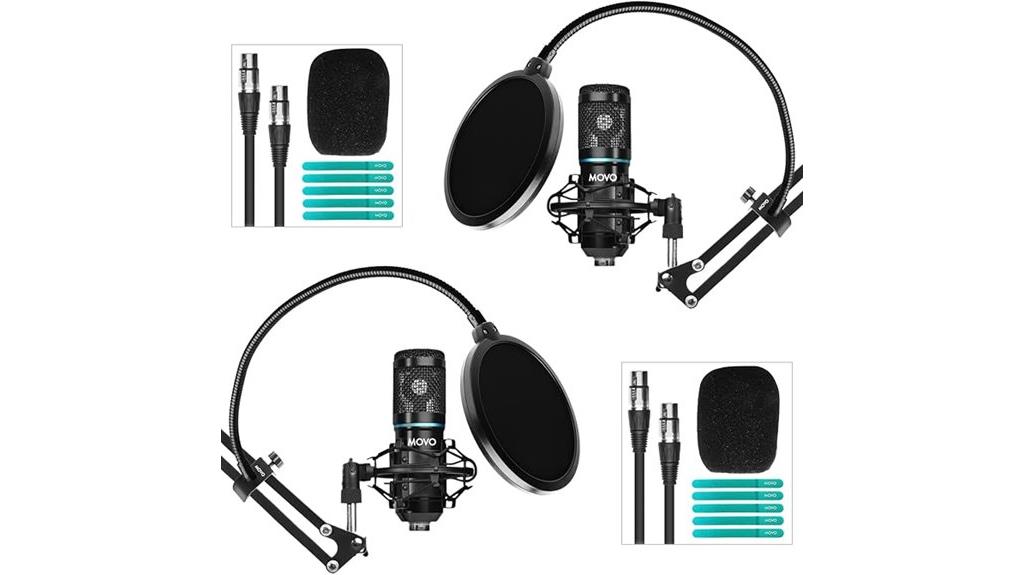
The Movo PodPak2A 2-Pack Microphone Kit with Arm and Accessories stands out as an ideal choice for home studio creators who want professional-quality sound without complicated setups. It features two cardioid condenser microphones that deliver broadcast-quality audio at 48kHz/16-bit, capturing clear sound across a broad frequency range. Each mic comes with a shock mount, windscreen, pop filter, and table stand, making setup straightforward. The desk-mounted arm clamps easily to your table, providing flexible positioning. With included XLR cables and a one-year warranty, this kit offers a reliable, all-in-one solution perfect for podcasts, streaming, or music recordings.
Best For: home studio creators, podcasters, streamers, and musicians seeking professional-quality audio with easy setup.
Pros:
- Includes two high-quality cardioid condenser microphones with comprehensive accessories for immediate use.
- Offers broadcast-quality sound at 48kHz/16-bit with minimal latency.
- Desk-mounted arms and XLR cables streamline setup and positioning for versatile recording environments.
Cons:
- Requires +48V Phantom Power, which may need additional equipment if not already available.
- Designed primarily for indoor use; portability may be limited due to the setup components.
- The kit may be overkill for casual or beginner users who need only basic recording solutions.
Wireless Lavalier Microphone, Compact & Versatile
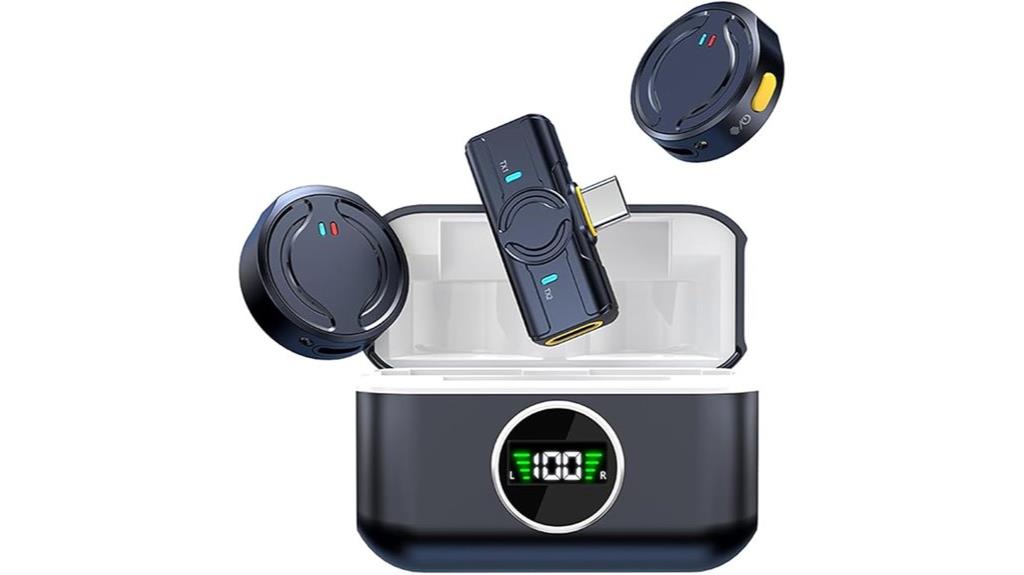
The Nuomitec wireless lavalier microphone stands out as an excellent choice for content creators who need freedom of movement without sacrificing sound quality. Weighing just 8 grams, it’s the lightest mini mic on the market, easily clipping onto any collar. Its compact design and charging case make it perfect for on-the-go use. It captures clear, lossless audio at 48kHz/24bit with a 70dB signal-to-noise ratio, handling loud sounds up to 115dB. With a wireless range of up to 1,000 feet and 20 hours of battery life, it’s versatile and reliable. Plus, compatibility with multiple devices makes it a top pick for mobile recording needs.
Best For: content creators, vloggers, and filmmakers who require high-quality, portable wireless audio with extensive range and long battery life.
Pros:
- Ultra-lightweight and compact design weighing only 8 grams for maximum portability
- High-quality lossless audio with a 48kHz/24bit format and a 70dB signal-to-noise ratio for clear sound
- Long wireless range of up to 1,000 feet and 20 hours of continuous recording
Cons:
- May require a USB-C adapter for compatibility with some devices
- Limited to line-of-sight transmission, which could be affected by obstacles
- The small size, while beneficial for portability, may be easy to lose or misplace
Zoom PodTrak P4 Podcast Recorder with Microphone & Phone Inputs
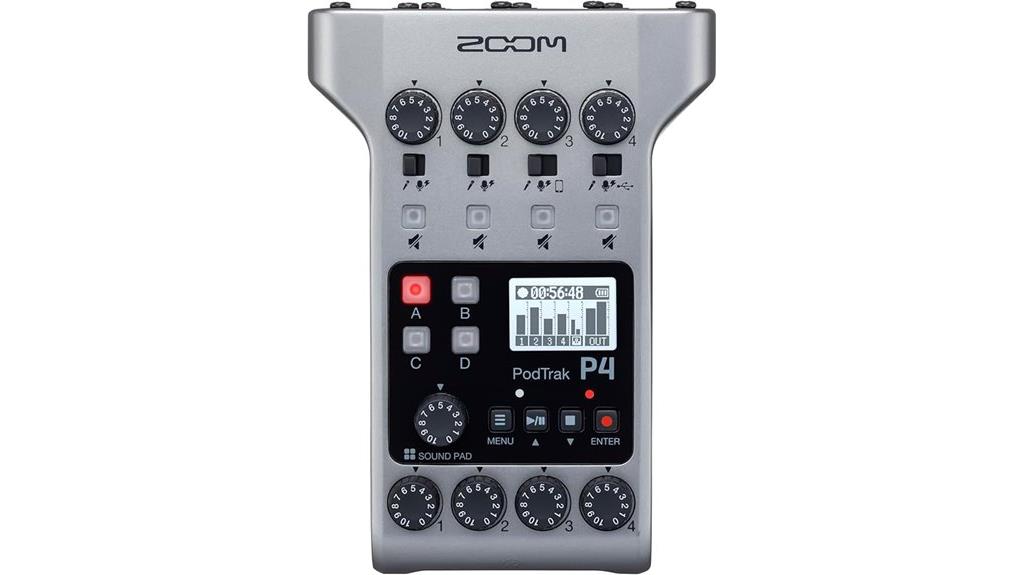
If you’re seeking a portable recorder that combines ease of use with professional-quality audio, the Zoom PodTrak P4 stands out as an excellent choice for podcasters on the go. Weighing just 4.6 ounces, it offers four XLR mic inputs with phantom power, four headphone outputs, and a phone input for call-ins. It records to SD cards and can connect to smartphones or computers via USB-C for streaming or editing. The intuitive interface features clearly labeled gain knobs, backlit mute buttons, and a 2-inch LCD screen that displays essential info. Its sturdy build, versatile connectivity, and sound pads make it perfect for high-quality, on-the-move podcasting.
Best For: podcasters and content creators seeking a portable, user-friendly recorder with professional-quality audio and versatile connectivity for on-the-go recording sessions.
Pros:
- Lightweight and portable at only 4.6 ounces, ideal for mobile use.
- Intuitive interface with clearly labeled controls and a bright LCD screen for easy operation.
- Multiple input/output options, including four XLR mic inputs with phantom power and four headphone outputs.
Cons:
- Limited recording quality at 16-bit/44.1 kHz, which is standard but not as high as some professional gear.
- Backlight only functions when powered via USB, potentially reducing visibility when on batteries alone.
- Plastic casing, while durable, may not provide the same premium feel as metal-bodied devices.
Factors to Consider When Choosing Studio Microphones for Podcasting
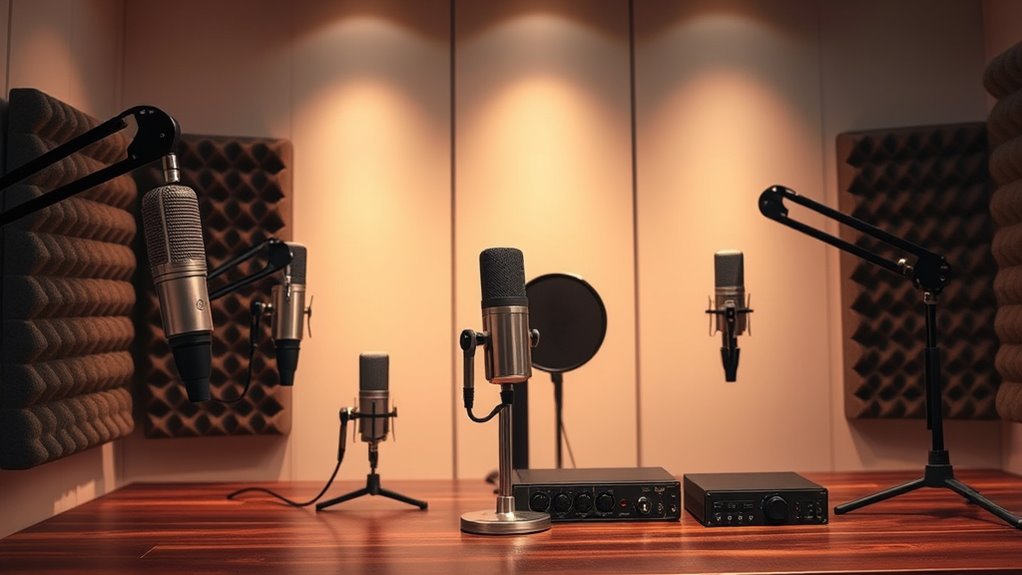
When choosing a studio microphone for podcasting, I consider factors like microphone type and sound quality to guarantee clear, professional audio. Connectivity options and your budget also play a big role in narrowing down the best fit. Plus, I look at how easy it is to set up, so you can start recording without hassle.
Microphone Type Selection
Choosing the right microphone type is essential for achieving professional-sounding podcasts, and it depends largely on your recording environment and goals. Dynamic microphones are great for noisy settings because their cardioid pattern rejects off-axis sound, minimizing background noise. On the other hand, condenser microphones offer higher sensitivity and wider frequency response, making them ideal for studio-quality vocal recordings in controlled spaces. If you’re starting out, USB microphones provide easy plug-and-play setup, perfect for beginners. However, XLR mics require extra equipment but deliver superior sound quality suitable for professional podcasting. The polar pattern also matters; cardioid captures sound mainly from the front, reducing room echo, while omnidirectional picks up everything around it. Your choice should align with your environment and the type of audio clarity you aim to achieve.
Sound Quality Importance
High sound quality is essential for creating engaging and professional podcasts because it guarantees that your vocals come through clearly and naturally. A microphone with a wide frequency response captures both low and high frequencies accurately, ensuring a balanced sound. Low self-noise and a high signal-to-noise ratio minimize background hiss and unwanted noise, preserving audio clarity. The microphone’s polar pattern, like cardioid, plays a key role in isolating your voice from ambient noise, making recordings cleaner. Consistently high-quality sound reduces editing time and enhances the listener’s experience. When choosing a microphone, prioritize these factors to ensure your podcast sounds polished and professional, helping you stand out in a crowded field. Sound quality truly makes or breaks the overall impression of your podcast.
Connectivity Options Needed
Selecting the right microphone connection is crucial because it directly affects how easily you can integrate your device into your existing setup. I recommend checking if the microphone offers USB, XLR, or both, depending on your equipment. USB mics are great for beginners since they connect directly to computers without extra gear. On the other hand, XLR microphones are preferred for professional setups, especially when using sound interfaces or mixers. It’s also important to see if the mic supports real-time monitoring through headphone jacks, which helps you control your sound quality. Additionally, verify compatibility with your computer or recording device, whether you’re on Windows, Mac, or other platforms. Don’t forget to check if you need adapters or cables—some may be sold separately.
Budget Considerations
Budget is a key factor when picking a studio microphone for podcasting, as it influences the features and quality you can access. Microphone prices vary widely, from under $50 for basic models to over $500 for professional-grade gear. Cheaper microphones often have limited features, such as fewer polar patterns, lower signal-to-noise ratios, and less durable construction, which can affect sound quality. To get comparable results, affordable mics usually need extra accessories like shock mounts or pop filters. Investing in a mid-range microphone offers a good balance between cost and performance, providing clearer audio without overspending. Setting a clear budget helps you focus on essential features like connectivity and frequency response, ensuring your microphone meets your podcasting needs without breaking the bank.
Ease of Setup
Choosing a microphone that’s easy to set up can save you time and frustration, especially if you’re new to podcasting. USB microphones with a plug-and-play design are a great option, as they don’t require extra drivers or software. They connect quickly to your computer or device, making setup straightforward. Features like built-in gain controls and mute buttons also help, so you can adjust sound levels and mute yourself instantly without fiddling with external equipment. Minimal assembly, such as attached shock mounts or boom arms, further simplifies the process. Compatibility with popular platforms like Windows, macOS, or gaming consoles ensures a hassle-free connection. Overall, an easy-to-set-up microphone lets you focus more on content and less on technical hurdles.
Noise Cancellation Features
Since background noise can be crucial to audio quality, it’s essential to look for microphones with strong noise cancellation features. Effective noise reduction ensures your voice remains clear and intelligible, even in less-than-ideal environments. Look for microphones with cardioid polar patterns, which help isolate your voice from ambient sounds. Built-in noise reduction tech, like filters and digital processing, can minimize electrical hum and environmental noise. External accessories, such as pop filters, windshields, and shock mounts, also help reduce plosive sounds and mechanical vibrations that contribute to noise. Additionally, proper microphone placement and room acoustics play a key role in maximizing noise cancellation. Combining these features ensures professional-grade audio quality that keeps background noise at bay, making your podcast sound polished and engaging.
Compatibility With Devices
When selecting a studio microphone, verifying its compatibility with your devices is key to ensuring smooth setup and reliable performance. First, check the connection types—USB, XLR, or both—to match your existing equipment and setup. Consider if the microphone supports your device’s operating system, whether Windows, macOS, Linux, or mobile platforms, to avoid integration issues. Also, examine the physical interface, such as USB-C, USB-A, or XLR, to see if it aligns with your device’s ports or if adapters are needed. Determine whether the microphone can connect directly or if you’ll require additional audio interfaces or mixers. Finally, review power requirements and phantom power options to ensure proper operation without complications. Compatibility is essential for hassle-free recording and consistent sound quality.
Additional Accessory Compatibility
Ensuring your microphone works seamlessly with essential accessories can considerably improve your recording experience. Check if it’s compatible with common items like shock mounts, pop filters, and boom arms to boost stability and sound quality. Make sure the microphone supports standard mounting threads such as 5/8’’ or 3/8’’ so it fits your stands and brackets easily. Confirm the connection type—USB, XLR, or both—to ensure compatibility with your existing setup. If you want real-time monitoring, verify that the microphone includes or can work with accessories like headphone adapters or extension cables. Additionally, consider whether the microphone’s design allows for attaching extras like RGB lighting or soundproof shields for customization. These details help create a versatile, user-friendly recording environment.
Frequently Asked Questions
How Do I Choose Between USB and XLR Microphones for Podcasting?
When choosing between USB and XLR microphones for podcasting, I consider my setup and needs. USB mics are plug-and-play, great for beginners and simple setups, while XLR mics offer higher sound quality and more control, but require additional equipment like an audio interface. If I want convenience and quick setup, I go for USB. For professional sound and flexibility, I prefer XLR.
What Are the Key Features That Impact Sound Quality in Studio Microphones?
I’ve found that key features like the microphone’s capsule quality, frequency response, and sensitivity really impact sound quality. A high-quality capsule captures more detail, while a broad frequency response guarantees clarity across vocals. Sensitivity affects how well it picks up your voice without noise. When I choose a microphone, I look for those specs, because they make certain my recordings sound professional and clear, making a real difference in my podcast.
How Important Is a Microphone’S Cardioid Pickup Pattern for Podcasting?
The cardioid pickup pattern is vital for podcasting because it primarily captures sound from the front, reducing background noise and echo. I find it essential since it helps keep the focus on my voice and minimizes distractions for listeners. If you want clear, professional-sounding episodes, choosing a microphone with a cardioid pattern makes a big difference, especially in less-than-ideal recording environments.
Can I Use Gaming Microphones for Professional Podcast Recordings?
Did you know that over 60% of beginner podcasters start with gaming microphones? I get why you might consider them, but for professional quality, they often fall short. Gaming mics tend to pick up more background noise and lack the clarity needed for engaging podcasts. I recommend investing in a dedicated studio microphone—it’s worth it for crisp, clear sound that keeps your audience hooked.
What Factors Influence Microphone Durability and Longevity in a Studio Setting?
When considering microphone durability and longevity, I look at build quality, materials, and how well it handles daily use. A sturdy metal body and quality components make a big difference, especially in a busy studio. Proper maintenance, like keeping it clean and avoiding extreme temperatures, also extends its life. Investing in reputable brands with good reviews gives me confidence that my microphone will last through many recordings.
Conclusion
Choosing the right microphone can transform your podcast, but the perfect pick isn’t always obvious. As technology evolves, so do the options—each offering unique features and sound qualities that could elevate your recordings in unexpected ways. Are you ready to discover which mic will unleash your true potential? The best choice is waiting just beyond the horizon—dive in, explore, and see how the right gear could change everything. Your next great episode might be closer than you think.

